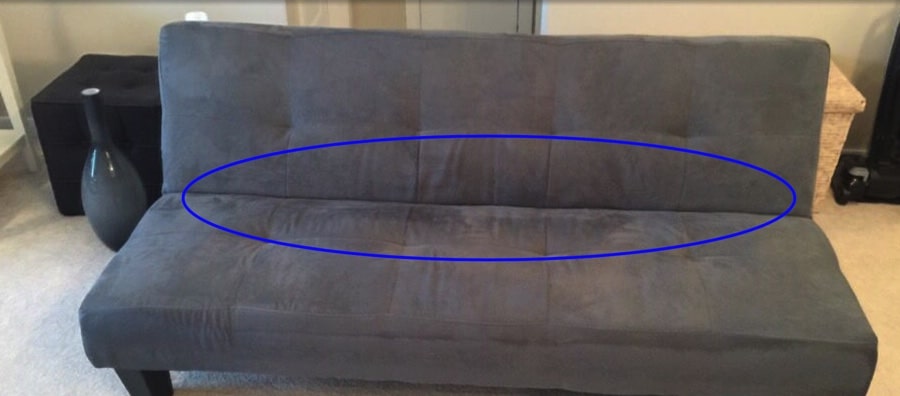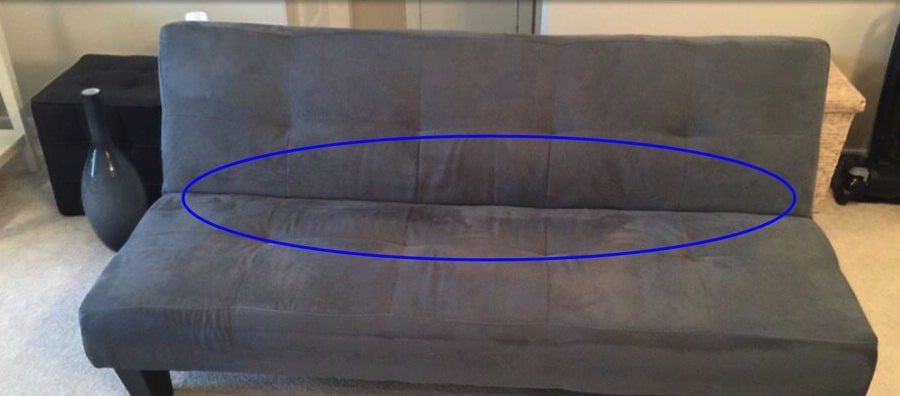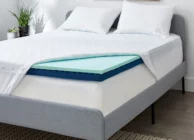Japanese futons, or shikibutons, are the traditional style of bed in Japan and are used on a soft mat called a tatami. Western-style futons, however, are very different from their Japanese counterparts because they can be used as both a sofa and a bed. Western-style futons usually have the dimensions of a mattress and are more difficult to fold, and they are often set up and stored on a slatted frame which enables them to fold. For more in-depth information, take a look at our ultimate guide to futon frame, mattress, and sheet sizes and our article about how futons work. Whether you have a Japanese futon or a western-style futon, many futon mattresses may begin to sag after some time. But how do you fix a sagging futon mattress?
To fix a sagging futon mattress, first try adding a board or plywood underneath your futon, then flip and rotate your futon mattress, clean and air out your futon mattress, try adding pillows underneath the mattress, and add another layer to your futon.
2 toppers to help with a sagging futon
Below, we’ll discuss these steps to fix a sagging futon mattress in more detail.
Step 1. Add a Board or Plywood To Fix a Sagging Futon Mattress
The first thing you should do when trying to fix a sagging futon mattress is consider getting a new mattress foundation. Surprisingly, the problem may actually be your mattress foundation rather than your futon mattress. Many people use futon frames with metal slats, and the metal can dig into the futon mattress and cause it to sag.
A simple solution to this problem can be putting a lightweight piece of plywood or a bunkie board (like this one) underneath the futon mattress. This can benefit you in two ways: First, the futon will be much more comfortable for you when you’re sleeping on it. Secondly, the futon will last much longer if you add this layer of support.
Step 2. Flip and Rotate Your Futon Mattress
It may help if you flip and rotate your futon mattress. Make sure that you rotate the top and bottom of your futon regularly to prevent any uneven spots from forming. Like any other mattress, your futon will start to sag if you always sit in the same spot, so you should try flipping and rotating your mattress once a month. When you rotate and flip your futon mattress, you’re helping it stay firm, redistributing the filling of your mattress, and helping increase the lifespan of the mattress at the same time.
Take a look at our guide to fluffing the cotton or wool in your futon mattress.
Step 3. Clean or Air Out Your Futon Mattress
To clean and air out your futon mattress, fold it over a fence or other surface and hit it several times with an old fashioned carpet cleaner or a broom. After hitting it, leave your futon in the fresh air and sunshine for about half an hour. This will help freshen up the mattress and help fluff up the futon’s stuffing. Your futon will be fresher, last longer, and sag less if you do this regularly. Zippered mattress covers are especially useful for making this task easy. We also have a step by step guide to how to clean your futon mattress that you should take a look at as well.
Step 4. Try Adding Pillows Underneath the Mattress
You might be putting your weight in the same place each time you sit and lie down on your futon, which can cause the futon mattress to sag. If you plump up your futon by adding some pillows underneath, especially on the ends, it can make your futon much more comfortable and it might fix your sagging problem. Firm talalay latex pillows can serve this purpose.
Step 5. Add Another Layer to Your Futon
If your futon is getting quite old and saggy and you have another futon mattress lying around, this can be an easy way to solve the problem for the time being. By stacking two older futon mattresses together, you can add some much-needed extra thickness to your futon.
Keep in mind that this isn’t a permanent solution, but it can help you out for a little while until you can figure out your next step. Also note that you cannot fold your futon mattress if you have another one stacked on top.
You may also be able to use a mattress topper to fix your sagging futon mattress. Take a look at our article on how to choose a mattress topper to fix a lumpy mattress for more details.
Reasons a Futon Mattress Might Sag
 A futon mattress might sag because of uneven filling, repeated stress in one area, or for a number of other reasons. Image from Decor Trends.
A futon mattress might sag because of uneven filling, repeated stress in one area, or for a number of other reasons. Image from Decor Trends.One of the main downsides to futon mattresses is that they can start to sag after being used for a while. All mattress owners should expect some sagging since mattresses will become softer after being used for some time; however, futon mattresses may sag faster than traditional mattresses because they are used for both sleeping and sitting. Sagging can result in an uneven surface that can make a bed feel very uncomfortable.
A futon mattress might sag because it isn’t flipped or rotated enough, or because of repeated stress placed on the mattress by always sleeping in the same spot. If a futon is used for both sitting and sleeping, this will increase the wear and tear on the mattress, which can cause it to sag prematurely.
Sagging most commonly occurs in areas that cushion the sleeper’s heaviest areas, such as the chest, shoulders, midsection, and hips. Sagging can be worse if a couple sleeps on the same futon mattress, particularly if they cuddle in the center of the mattress while they sleep. Pets can also worsen sagging. If you have a dog or cat that sleeps on your bed, it is possible that they could leave a sinking spot in your futon. If you don’t rotate and flip your futon mattress enough, the mattress will become much less firm in these areas.
Some side sleepers may actually benefit from sagging because their position requires extra cushioning at the shoulders and hips in order to align the spine. On the other hand, too much sagging can have a negative effect, and even minor sagging can negatively affect spinal alignment for back and stomach sleepers. For more information about spinal alignment, see this study.
To relieve shoulder pain, you might consider buying a mattress topper instead of fixing your sagging futon. Also, if you’re noticing a difference in the edges of your mattress, make sure to take a look at what to do if your mattress edge collapses for some ideas.
When Should You Replace a Futon Mattress?
You should replace a futon mattress when it is worn out, ripped, or damaged, or when it is sagging. Typically futon mattresses last between 5 and 10 years.
The lifespan of a futon mattress depends on its durability. Futon mattresses will last longer if they’re used lightly and taken care of properly. If a futon mattress is well taken care of, you can expect it to last between five and ten years. If you have had a futon mattress for a long time without taking care of it properly, it may be time to replace it.
To extend the life of your futon mattress after replacing it, make sure to clean it often and flip and rotate it regularly. Removing moisture from your mattress as well as preventing moisture from getting into your mattress will allow your mattress to be used for much longer. For more information about mattress cleanliness and why it is important, see this study.
If you’re in the market for a new futon, take a look at our favorite futon mattresses.
How To Fluff a Shikibuton
To fluff a shikibuton, squeeze and shake the futon to adjust where the cotton filling is distributed. You can also hang the shikibuton up and beat it with a broom.
All-cotton shikibutons, or traditional japanese futons, tend to form dips where the body is positioned. If you lie in the same place every night, rotate the shikibuton every few days. Whenever you feel it getting too flat or notice the cotton filling migrating from one part of the mattress to another, you should rotate and fluff your shikibuton.
One way to fluff it is to squeeze and shake the shikibuton so that the cotton migrates to another area of the mattress. Then, you can fluff it to get the cotton back into the middle where your body has most likely created a flat, fluff-free spot.
You can also fluff a shikibuton by hanging it up and beating it with a tennis racket or a broom. However, keep in mind that you don’t need to beat it with a lot of strength; just hit it a couple of times until the fluff is equally distributed throughout the mattress.
How To Fluff a Western Futon Mattress
To fluff a western futon mattress, unzip the mattress cover and fluff the foam inside the mattress with your hands, making sure to add new stuffing if the foam has flattened too much. Once you finish, hit the futon mattress with a broom or a tennis racket to make sure that the filling is evenly distributed.
Western futon mattresses are usually filled with cotton or foam. Because western-style futons are often used for both sleeping and sitting, they tend to develop dips in their surface. These dips aren’t only unsightly, but they are uncomfortable and may cause back or leg discomfort for people using it (for more information about bed ergonomics and how they affect sleep, see this study). However, with regular rotation and fluffing, a futon mattress can retain its original shape.
To fluff a western futon mattress, follow these steps:
Step 1. Locate the Zipper of the Futon Mattress
Locate the zipper of the futon mattress and open it to find the inner stuffing.
Step 2. Fluff the Foam Inside the Mattress
Use your hands to move the stuffing around and distribute it evenly so that you fill the empty or flattened spots. If there isn’t enough filling to fluff the mattress, add some extra foam or another soft material to fill in the gaps.
Step 3. Hit the Mattress to Distribute the Foam Evenly
After fluffing up the filling, zip the futon mattress back up and beat the mattress with a heavy object like a broom or tennis racket to distribute the stuffing evenly.
Related Articles:



